This is list of compositions and performances. Podcasts, soundscapes and soundtracks: this page.
| Trill (2024) | performer and music robot |
| Mimba Shorts (2024) | 1 performer |
| Robody (2024) | dance performance |
| Gram (2024) | noise gramophone |
| Planet Jong Dzin Pong (2023) | children's performance |
| Street Sonatas 5 & 6 (2021) | 2 performers |
| Glass II (2020) | 2 performers |
| Street Sonatas 3 & 4 (2020) | 2 performers |
| Here and There (2017-19) | 1 or more performers |
| Street Sonatas 1 & 2 (2019) | 2 performers |
| Anemoi (2018) | minimum 2 performers |
| Glass (2018) | 2 performers |
| Rollende Band (2018) | minimum 3 performers |
| Not Necessarily Music (2018) | 2 performers |
| Aria (2017-18) | 4 performers |
| Trajectories (2017-18) | 4 performers |
| No Room (2017) | minimum 2 performers |
| Music Street (2017) | local musicians |
| Hearizon (2016) | minimum 3 performers |
| Plain (2016) | minimum 4 performers |
| Beving Rozebroeken (2016) | ensemble |
| Open Fields (2016) | ensemble |
| Rasuren (2015) | ensemble |
| Points to make (2014) | minimum 4 performers |
| (fl)ASH (2012-14) | ensemble |
| Centra (2013) | ensemble |
| Eigengang (2011-12) | 1 piano - 3 pianists |
| Chunks & Streams (2011) | electric guitar quartet |
| Threeway II (2010-11) | 4 instruments |
| Gort (2008) | (amplified) string quartet |
| Soffitto (2008) | 2 music automats |
| Drieweg (2007) | 4 performers |
| Patchwork (2006-...) | a cycle of live electronic compositions for amateurs |
| Radio South (2006) | radios and 2 optional instruments |
| Slow Motion (2006) | 11 automatic instruments & computer |
| Point Black (2006) | piano and live electronics |
| Different Ways (2006) | ensemble and live electronics |
| Temperate Music (2005) | live electronics |
| Colo (2005) | electro-acoustic work |
| Ohne Worte II (2004) | voice, vla, perc & electronics |
| Dubbelstuk (2003-04) | automatic piano & pianist |
| Ohne Worte I (2002) | voice, vla, perc & mengpaneel |
| How it takes place (2001) | ensemble |
| Silence Reserves (2001) | vl, vla & tape |
| Run! (2000) | ensemble and tape |
| ...von Hunderten, von Tausenden... (1998-2001) | string orchestra |
| Nowhere's Chaos (1998) | ensemble |
| Nature Morte (1997) | ensemble |
| Phoenix (1996) | ensemble |
| Sailing the seas of down below (1995) | piano automat |
| 8 short songs (1995) | voice and (prepared) piano |
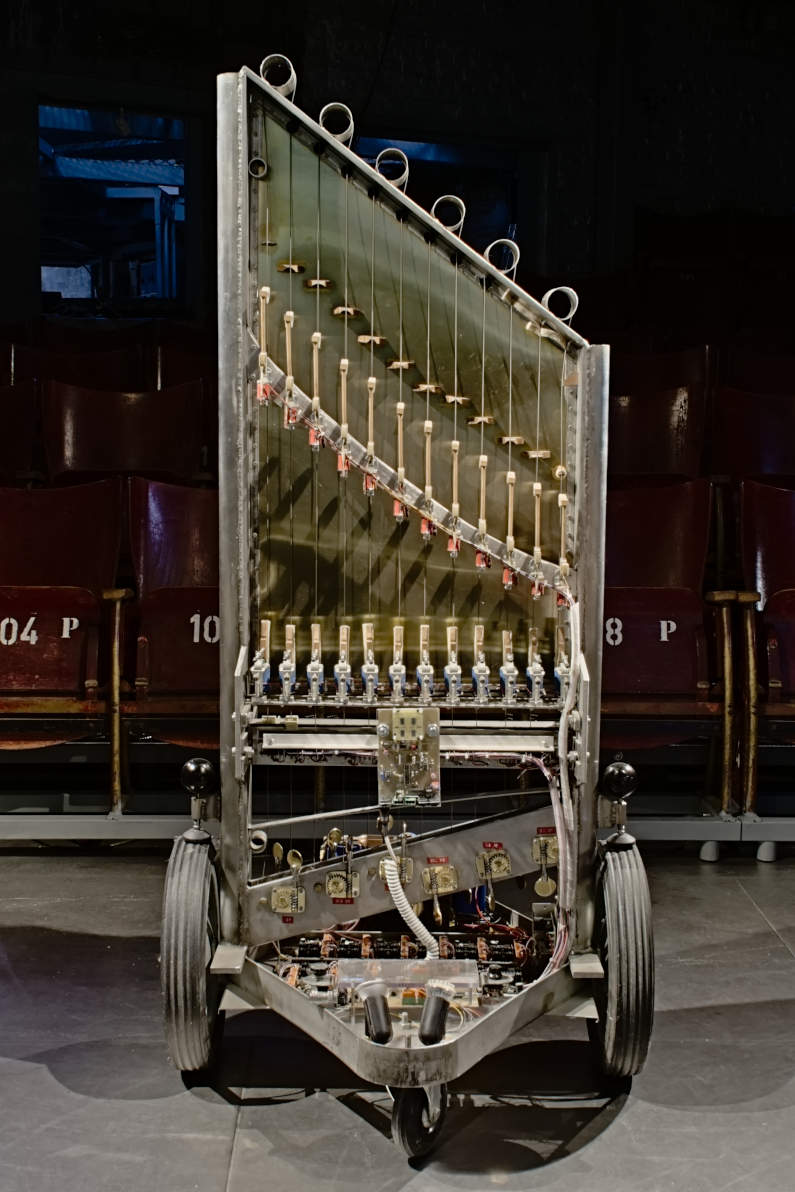
This is a work for Aeio, a music robot of the Logos Foundation, built by G-W. Raes. This instrument has 12 strings, each string has an electromagnet that makes the string vibrate (like an ebow mechanism) and a hammer to beat the string (like a piano). The string vibrations are also influenced by the vibrations of the other strings and previous vibrations. Moreover, a small change of pitch or loudness may have a big sound effect: the fundamental (pitch) or an harmonic may suddenly start or stop to resonate. This unpredictability and sensitivity for history and context fascinated me to make a live improvisation and exploit these characteristics.
Aeio has many parameters to control and play this computer-controlled instrument. In Trill I restrict and bundle these parameters. Four strings become the foreground and 8 strings the background. You hear the lower harmonics of the main four strings and the higher ones of the eight side strings. Via a MIDI controller and patch (in Pd) I control four parameters per main string in real time. The 8 background strings are bundled in my patch: they change via algorithms. I can switch these algorithms on during the performance and assign them to (specific) background strings.
• performance on 19 December 2024 in Logos.
• live recording of the performance (19 december 2024):
• Pure Data patch (files in one zip file, open this file: main-trill-aeio.pd, version: dec24).
Mimba Shorts
This will be a bundle of works for the (software) synthesizer Mimba, which is played live with a MIDI piano keyboard. This synth is based on algorithms that mimic physical processes (vibrating strings, air blowing through a pipe, etc.). It was made by Hans with the audio programming language Pd). On purpose the synth has no homogeneous timbre, pitch and velocity differences create diverse sounds (for example because they change internal feedback processes).
• Recordings of 2 parts from Mimba Shorts: first a live performance of 'Pendulum':
and a second part (working title 'Digitab' with an algorithmically generated bass):
• Short demo with Hans playing a fragment from the second part 'Digitab' (without using the midi controllers of the Mimba synth):
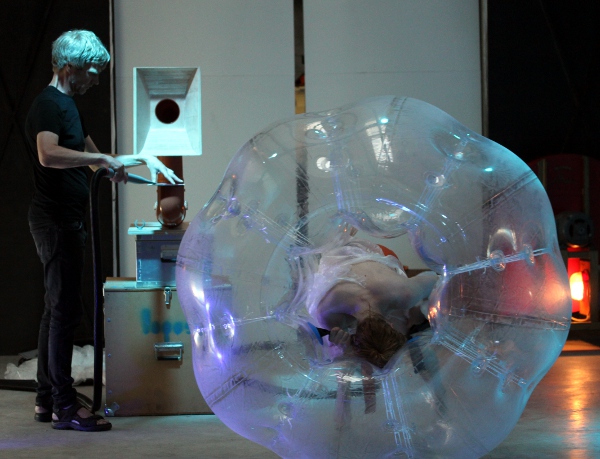
photo: Christel Vastenavont
Robody
A physically challenging dance performance about bodies and forms of life, growth and decay, in collaboration with dancer Emilie De Vlam and composer Kristof Lauwers. In first part Emilie moves in, out and around plastic sculptures while Hans plays the noise gramophone. In the second part her movements and gestures make the Logos music robots play.
• performances on July 23, 24 and 25 2024 in Logos.
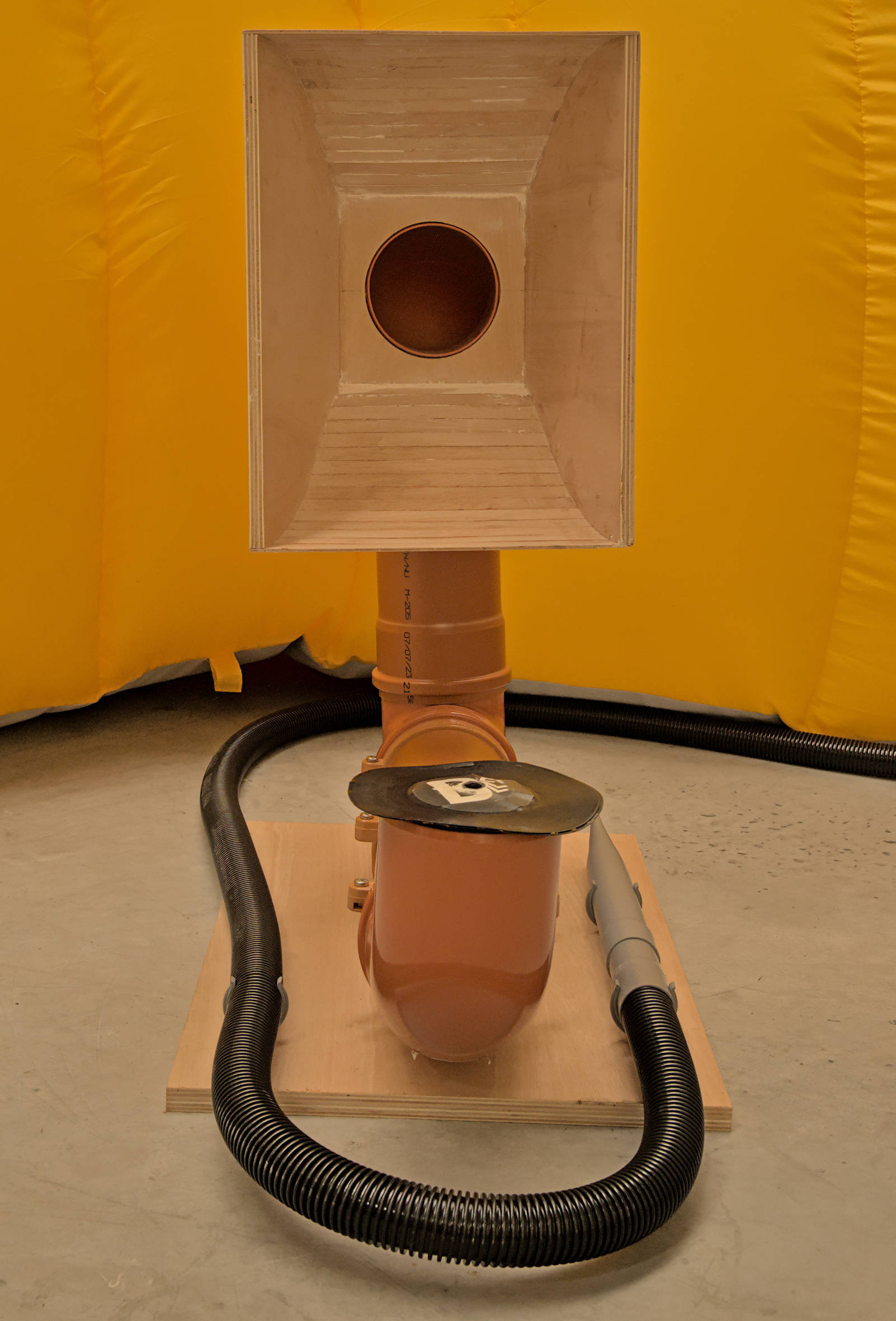
Gram: Noise gramophone improvisations
Improvisations for the noise gramophone. A blower (compressor) blows air through holes and against surfaces of a vinyl record or single and also makes rubber or plastic bands or strings (attached to the vinyl) vibrate. The sound result is a multilayered noise, amplified with an acoustic horn as in oldfashioned record players. This noise gramophone is part of the Susurrus sound installation, designed together with Mattias Parent in the Logos Foundation.
1_gram (impro test-grammo31mei24-take2.wav):
4_gram (impro snel-susurrus12jun24-zoom22.wav):
5_gram (impro snel-susurrus12jun24-namiddag-zoom25.wav):
3_gram (impro snel-susurrus12jun24-zoom19.wav):
2_gram (impro snel-susurrus10jun24-zoom14.wav):
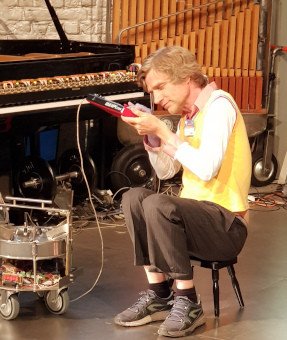
Planet Jong Dzin Pong
A performance for children created for the Logos Foundation, in collaboration with Emilie De Vlam and Kristof Lauwers. The young audience walks through the Logos buildings and encounters concerts, dance acts and performances with the Logos music robots.
• performed on July 18, 19 (Gentse Feesten) and November 19 2023 (Art Day for Children) in Logos.
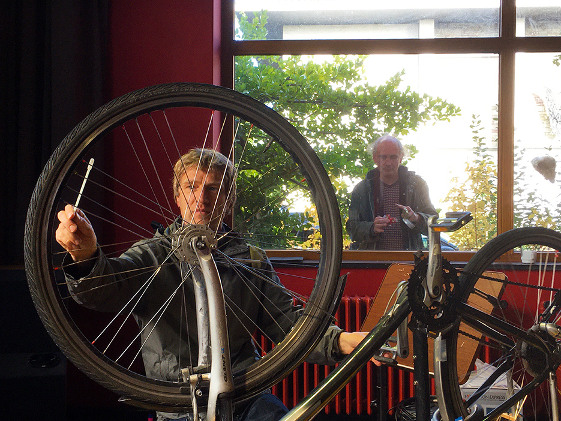
photo: Wouter Cox
Glass II
In Glass II the audience sits inside and looks through large windows at the outdoor landscape. Environmental sounds are captured by microphones and played back in the inside audience space. Two performers give musical comments in this inside space but they also walk in and out of the landscape with instruments or microphones.
Glass wants to be musical landscape art in which inside and outside spaces, performed music and indeterminate environmental sounds create an overarching, audio-visual composed space.
The dialogue between stasis and movement is the central focus of this second Glass composition. The musicians play on (amplified) bicycles and rotating, rolling objects such as spinners. Different types of microphones and recording techniques -used live- mainly aim to create (wide, closed, intimate) spaces within the overall, physical concert environment.
• performance: 10 October 2020 by Stefaan Smagghe and Hans Roels in Postx.
• audio recording and more information on the realization and performance of Glass II on 10 October 2020 on this page.
• text score.
Here and There
Above all, Here and There is a work for performers, it is an exercise or meditation with a 'remote instrument': a music instrument that you play in one place but sounds in another place of the direct surroundings. For example: you play in your living room at home on a keyboard and synthesizer and they sound through an open window via a portable speaker, hanging in the branches of a tree 15 meters further away. By extending an instrument and integrating the environment, the performers looses a sense of individuality. He or she cannot accurately discriminate the instrument sounds from the environmental soundscape. Simultaneously, the performer connects more deeply to the surrounding environment.
• a text on my blog on the realisation of Here and There through a collaboration with Vincent Caers.
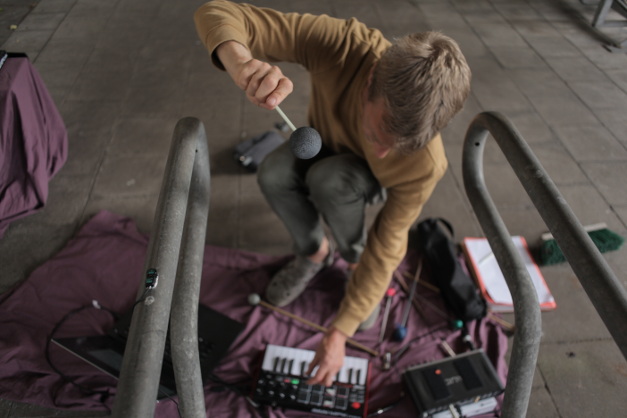
Street Sonatas
The Street Sonatas are duo pieces in which the performers play on metal street objects (a bench, fence, bridge, traffic signs, play structures for children, etc.) With contact microphones, laptops, controllers and percussion mallets they transform these objects into electro-acoustic instruments. Both performers play on the object with one hand, while performing on a (keyboard) controller with the other. The live electronics are 'tailor-made' and based on a preparatory analysis of the street objects.
The performers explore the many 'site-specific' (pitched, inharmonic, noisy) timbres of the object and simultaneously extend its sound possibilities with live electronics. They also integrate the sound environment around the sound object in the performance. Techniques which re-appear through the Street Sonatas are: creating a tuning and pitch system based on the characteristics of the street objects; pitch-shifting the contact microphone input combined with exploiting the timbres of the street object by playing with percussion mallets on different places (timbres) of the street object.
The Street Sonatas display an interest in an ecological materialism: a care for the sensuous life of things and objects in our world. A bench or bridge may be characterized by unique sounds, be part of the habitat of animals or plants, change through weather and time, have a longer lifespan than humans, urge people to sit and walk in a specific way, receive personal and social meanings for local inhabitants or passers-by, etc. Things and objects have a life of their own, while simultaneously interacting and relating to the living world of humans, animals, plants and natural forces around them.
In 2021 two new Street Sonatas were created: in the Street Sonata #5 "Swing" the clash between materials and the swing movement play a central role. A small object is swung against the street object and both have a contact microphone attached. The swinging movement produces a kind of wavy rhythm, with irregular, hard to control postvibrations when the objects just (not) touch and hit each other. The collision -of two materials- continuously produces two different sounds. The Street Sonata #6 "Wind" focusses on the sound of the wind at the performance site. The sound of the wind on wires, fences, branches or holes in objects with tubes is captured by microphones and incorporated in the performance. The street object is transformed into a music instrument in which sound level and pitch are linked to each other, analogous to (some) wind sounds.
These are live video recordings of performances in Ghent (Belgium) at the Keizerpark (2019) and De Krook (2020) of the Street Sonatas 1 to 4, together with Ruben Orio. On this vimeo website you can watch videos from June 2021 of the Sonatas 1, 2, 3, 5 and 6.
-----

Anemoi
Standing at a windy location two performers carry two kind of microphone instruments: long tubes with a very sensitive microphone in each tube and a stereo couple of microphones, connected to a laptop with a live electronics patch. By changing the direction of the long tubes, these tubes catch the sound of the wind and environmental sounds. They also create filter effects by picking up the reflection of wind and environmental sounds against walls, buildings and objects. The stereo microphone instrument maps the strength of the wind to sine waves in the laptop patch. Additionally, the performers sparsely play the tube and stereo instrument as a music instrument by blowing, breathing, beating, speaking, etc.
The Anemoi performance reveals the changing, living wind as it flows and hits against ears, tubes, trees and buildings. The tube and stereo instruments capture the wind as it moves through daily activities and influences our hearing, sounding and living. The wind is an invisible percussionist, beating, blowing and playing on ears, bodies and objects. For a short period of time Anemoi tries to capture this ghostly musician...• performance: 17 December 2018 on the Experiments are More Refreshing than New Socks (Research Festival) of the Conservatory in Antwerp. The two performers were Ruben Orio and Hans Roels and stood on the roof of the Singel, the audience was watching through the windows of another building of the Singel. There was also a performance on 23 August 2019 in DOK (harbour of Ghent). Ruben Orio and Hans Roels played from an old harbour crane while the audience was watching and listening in DOK.
• here are two short video clips of the try-out concert in the harbour of Ghent.
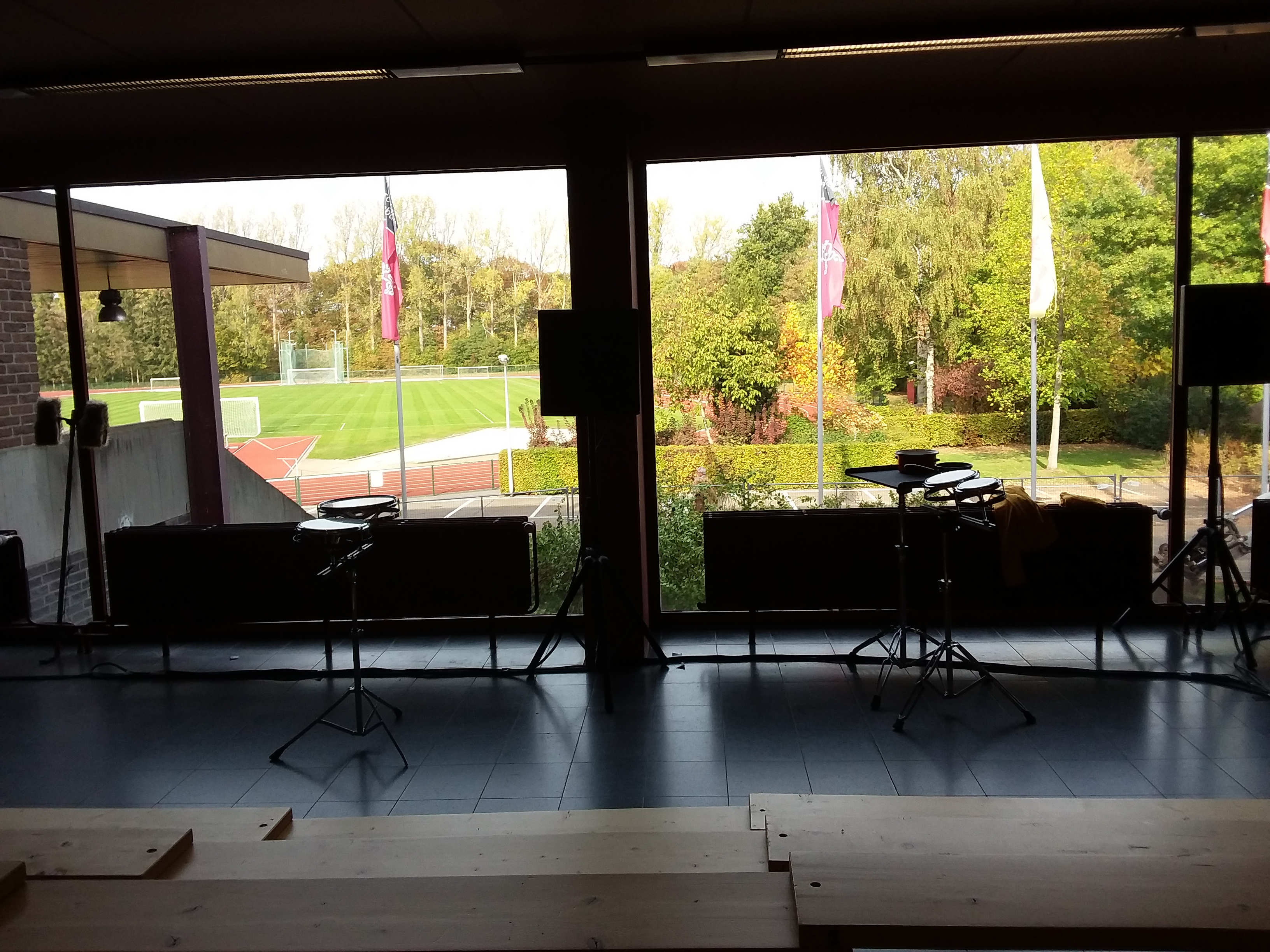
Glass
In the composition Glass the audience is seated indoors, in a space with large windows, as an office or bar. In the first performance at the Oortreders festival in Belgium the audience was looking at a landscape with a street, a sports ground and trees. Through open doors they acoustically heard the outside sounds. Two performers with microphones were walking outside. Using omnidirectional, directional and close microphone techniques they brought (selections of) outside environmental sounds to the PA speakers in the audience space. Two other musicians played percussion and synthesizer, both inside and outside the audience space. Sometimes they were audible acoustically, sometimes amplified through the PA speakers, when the microphone performers picked up their sound.
Glass wants to be musical landscape art in which inside and outside spaces, performed music and indeterminate environmental sounds create an overarching, audio-visual composed space. A kind of dream space in which you are both observer and participant. The dream is collective, not individual.
• performance: 20 October 2018 by the Collectief Publiek Geluid ('Collective Public Sound') at the Oortreders festival.
• audio recording and more information on the realization of Glass at the Oortreders festival on this page.

Rolling Band
Rolling Band is a work for several walking performers, moving a trolley suitcase along a trajectory with different street stones. The trolley is amplified with a contact microphone and portable speaker in the trolley suitcase. The performers try to play together with a rhythmic click track transmitted via a wireless sender. This track also functions as a kind of script and contains (sound) signals to slow down, stop, etc.
• my archived blog with more information on (an older version of the) Rolling Band.
• performances: 23 June 2018 (Ghent), 21 September 2019 (Coyendans, Gent), 28 november 2019 (Northern Light Parade, Antwerp).
• this is a short video fragment of a rehearsal in Antwerp. The sound recordist follows the performers and a gopro camera (at the bottom of the screen) is attached to one of the trolley suitcases.
• live audio recording (fragment) of the try-out in 2018.
Not Necessarily Music
Not necessarily music is a work for 'silent' musicians: people can just watch the performance or - if they want to - listen via a headphone. This work is an ode to a public, quiet place like the Krook library in Ghent (Belgium).
Thanks to technology such as smartphones, internet or headphones people can not only work, study or read at home or in their office. They can also listen to music or play piano in a public space such as a library. In this library there is a silent grand piano on which people can play or practice with headphones on. Performing music becomes a semi-private, semi-public activity in this way. Passer-bies see an intriguing visual performance but they can only guess what the musician is playing for him/herself. Just as you can only guess which messages you see people sending, or which sounds the outdoor environment - visible through large windows - is making.
This game of exposing and hiding, and creating a public space, controls Not necessarily music. In some sections the musicians are only playing for themselves. Nor the co-performers, nor the audience hears the 'original' music. In other sections they only play visually together or they listen to the same environmental sounds (arriving from a microphones placed outside the windows of the building) but do not hear each other. In some sections they also play together as 'real' musicians, listening to each other.
• performance: 23 May 2018 in the reading room of the Krook library (Ghent) by Ana Filipa Botelho (wind controller) and Quentin Meurisse (keyboard).
• live audio recording of the first performance on 23 May 2018.
• the score and extra documentation.
Aria & Trajectories
These two pieces were made for an indoor location with lots of daily objects and materials, such as a living of a house, a cafe, a community place, etc. Both pieces weren't performed yet, they were rehearsed but the concert projects didn't take place.
Aria is a site-specific performance with (minimum) four performers blowing air into holes, cracks and against objects and surfaces in a room. This happens not only with the mouth but also with spray cans or compressors. The audience hears and sees what happens if the wind could blow through a building and produce various noises and whistling sounds. The performance is meant to take place in a enclosed, not to large space, in which people live or work to ensure that all kinds of daily objects are present at the site. In Trajectories four percussionists beat a continuous pulse on objects, tables, cupboards, floors, walls, etc. in a living room or other space. They never beat on the same spot but move along a trajectory on those daily objects to create subtle, gradual timbre changes. They play crescendi and diminuendi, independently from those timbre changes. They scan the daily objects. The audience sees and hears how a distance of just a few centimeters on a wall or floor can create another sound world.• audio recording of a rehearsal of Aria in December 2017. I cut out a few fragments and thus reduced the duration of approx. 15 minutes to 5 minutes.
• the (provisional) scores of Aria and of Trajectories.
No Room
A living room, house or concert hall has borders, creating an inside and outside experience. Enclosed spaces - and their borders - leak and bring sounds from outside to the inside space. When the inside becomes silent - at night - the walls become audible and start to speak.
In No Room the surrounding architecture of an enclosed space is explored. Performers play outside the concert space on adjacent walls, floors, pipes, ventilation systems, etc. The sound reaches the audience through these walls and architectural objects. A microphone also records sound in real time outside the concert space and fragments of this live recording are played in the concert space.
• performance: friday 8 december 2017 in Miry Zaal (School of Arts, Ghent) by the Third Guy.
• the score and extra documentation.
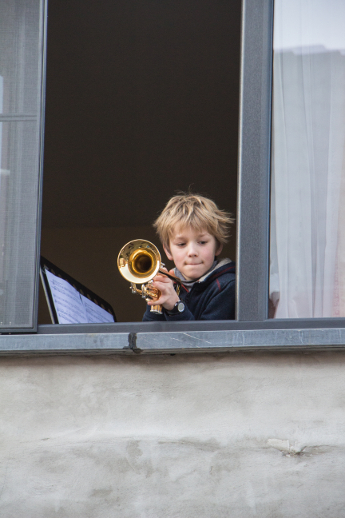
Music Street
In Music Street local musicians play from houses with open windows or doors. The audience walks in a street parade together with two accompanying musicians. This results in a collage of music fragments blowing through the street. This work wants to reveal the (sound) diversity in a neighbourhood: the multiple music styles, the various ways to enjoy music and the sound transformations by the local architecture and acoustics.
• performance: saturday 21 January 2017 in the Biekorfstraat and Zeemstraat (Ghent), realised in collaboration with the neighbourhood committee de Biekorf. From 20 locations along the trajectory of the parade more than 25 (mainly amateur) musicians performed, together with Aya Suzuki (percussion) and Thomas Moore (trombone) in the parade.
• live recording of the whole performance of 21 Januari 2017.
• blog page on the artistic, compositional choices made in Music Street.
• the score and extra documentation.

Hearizon
In an open landscape musicians walk away from the audience, the performers play instruments with different loudness levels. The place and moment at which their music disappears, becomes inaudible and is absorbed by the environment is different for each performer. The audible horizon of each performer lies at a different distance from the audience. Each musician plays his own music and walks his own trajectory. This creates a spatial polyphony of distinct parts that gradually become softer and are transformed by the environment and its sounds.
• performance: 22 december 2016 in the Park Spoor Noord in Antwerp, performers: Thomas Moore (trombone), Aida Lopez (piccolo) and a bagpipe band (Metropolitan Antwerp with Adam Clarke). The music that was chosen to create this specific version of Hearizon was based on the visual and auditive experiences in this park. This music was: Eisenbahn-Lust-Walzer by J. Strauss, the song In diesen Wintertagen by A. Schoenberg and the traditional Green Hills.
• performance: 2 june 2017 at the burial site Campo Santo (Ghent), a version with trumpet (Bert Bernaerts), saxophone (Pol Mareen) and percussion (Wim Konink). The music for this specific version of Hearizon was the Renaissance Villanelle 'Io volo sopra il cielo', the folk song 'Ich habe der Fruhling gesehen' and the romantic song 'Die Jungfrau und der Tod' (Carl Loewe). This choice was based on the contradiction at Campo Santo between the beautiful (spring) nature and wide, open sky on the one hand, and the graveyard and related themes such as death and departure on the other.
• live recording: the first 10 minutes of the performance at Campo Santo (trumpet, baritone sax, glockenspiel and environmental sounds such as an air plane, train, birds, etc.).
• the score.
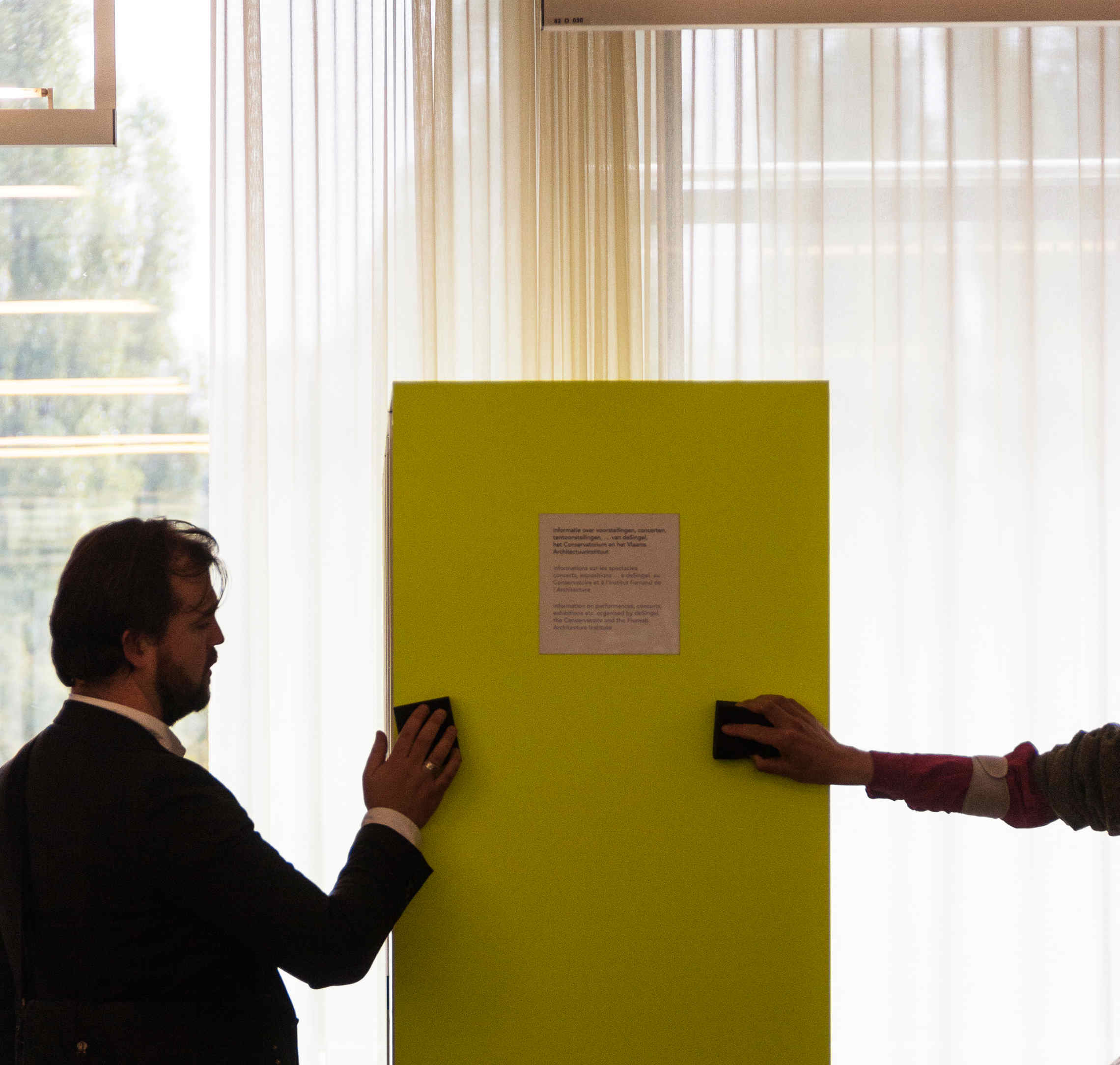
photo: Zena Vanden Block
Plain
Plain is a work for an inside space or a small, enclosed outside location. Continuous homogeneous tones or noise sounds are triggered or stopped by short sounds. All sounds are based on the frequencies, sounds, materials and architecture in the performance space. Consequently an alternation is created between static, frozen sounds and silences, after which new and old (voluntary and involuntary) sounds appear.
• performance: 27 october 2016 in the reading room of the library of de Singel (Antwerpen) at the Articulate Research Days.
• instrumentation: minimum four performers. The number of performers depends on the size and acoustics of the concert location.
• the score and extra documentation of this text score.
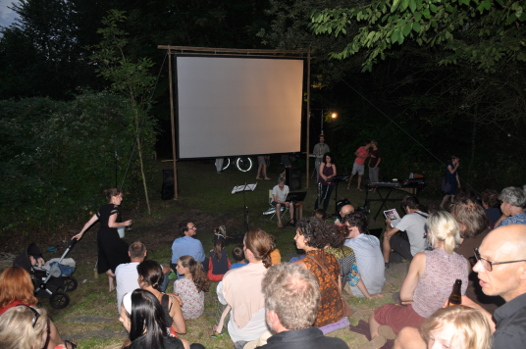
Beving Rozebroeken (Bebung)
Beving Rozebroeken (Bebung) wants to make the concert site vibrate audibly. The main (instrument) part requires multiple performers to beat on plants and objects (trees, stones, water, park benches, garbage, bicycles, etc.) situated at the concert site or characteristic for this place. The audible, present environmental sounds are part of the performance, but the focus is more on the hidden, implicit sounds that are contained in objects and need to be brought to life. More information available in my archived blog.
• performance: 27 August 2016 in Rozebroeken park during the Cinepuur festival (open air film), supported by the City of Ghent.
• live recording: the first five minutes of the performance in Rozebroeken park.
• the score and the video (animated score) for the percussion part (on site-specific objects).
Open Fields
Open Fields is to be performed in a large (outdoor) space. Four musicians are spread at a large distance around the audience, while three other players are located near to the audience. During the performance three of the four (far-away) performers gradually move in the direction of the audience. This piece builds upon the 20th century tradition to exploit the location of instruments in a music performance. In this work I try to obtain an auditory transparency: the music should not only draw attention to itself but also to the surroundings. During a concert the audience should not only hear the music, but also experience and learn about the concert environment.
• performance: 27 August 2016 in Rozebroeken park during the Cinepuur festival (open air film), supported by the City of Ghent.
• instrumentation: soprano sax, trombone, percussion (2 performers), flute, clarinet, accordion
Rasuren
Similar to the previous composition (fl)ASH this work consists of short fragments in diverse styles that are announced or cut off by the (solo) percussion. Rasuren stands for an old correction method by which mistakes were scratched off the paper with a knife and corrections were written on top of them. Rasuren is partly inspired by the creative process of Beethoven who wrote many sketches and versions while composing.
• written for the Deleuzabelli Variations project of Paulo De Assis and the Hermes Ensemble.
• performances: 29 september 2015 in the School of Arts Ghent and 9 november 2015 in the Bijloke concert hall of Ghent.
• score
Points to make
This work was made for a visual installation of the artist Alice De Mont. The composition consists of five parts or sections that can be performed in any order, with repetitions and/or omissions. The instrumentation is free and the musicians are invited to find different ways to perform staccato sounds (with pitch) on their instrument. The timing of these short notes is written in free time, resulting in a heterophonic texture.
• recordings: version 1: part B (loud) followed by part E and part B (soft)
• recordings: version 2: part C followed by part D
• score
(fl)ASH
(fl)ASH is based upon the blinding effect of a short music fragment. If a music fragment of a few seconds is followed by a silence, a moment of dazzlement is created during which the listener can think about the fragment and try to re-imagine it. By abruptly breaking off the fragment I try to strengthen this 'internal reverb' effect (in the head of the listener).
(fl)ASH is a static composition that stresses the 'here and now'. The structure is minimalistic and suggestive: in the short term there are repetitions of (similar) fragments, but on the long term -time structures longer than 30 seconds- there are almost no references to previous fragments. Moreover, the listener can create his/her own relations between the diverse fragments.
(fl)ASH is notated as an open, graphic score for which unfinished music has to be searched. The fragments are chosen from works that were never finished by the composer, often because he/she died during the composition process or because the material production (e.g. of an opera) appeared to be impossible. The first version of (fl)ASH used fragments of unfinished compositions by J. Haydn, J.S. Bach, W.A. Mozart, Fr. Schubert, H. Berlioz, F. Mendelssohn, Pappalardo, C. Saint-Saens, Fr. Liszt, Cl. Debussy, H. Vieuxtemps, G. Mahler, A. Bruckner, L. Ornstein, B. Bartok, A. Webern and Sorabji. Fragments were also based on my own sketches and sketches of (the performers) Patrick Housen and Dennis Allegaert.
• performances: in the Royal Conservatory of Ghent on 31 March 2014 and 15 October 2014
• recording (the first 5 minutes of a version with solo percussion, onstage ensemble (2 violins, viola, cello, flute, clarinet, harp, saxophone, piano, percussion), offstage ensemble A (horn, standing piano) and offstage ensemble B (accordion, bass clarinet, guitar)
CENTRA
The piano and the piccolo play a central role in this work. Both go their own way: the piano in the foreground, the piccolo in the background. The other instruments of the ensemble create a environment of short, contrasting fragments around these two instruments. Some ensemble fragments -almost- develop into an independent third voice, other fragments appear just once, as a chance event.
This work tries to create a sense of musical dept or distance. The spatialisation of the performers, the timbre and the musical material serve this goal.
To synchronize the parts with their own, independent tempi, the piano functions as a kind of clock. Almost all the synchronization cues are based on this part, thus the other instruments mainly follow the piano. As in chamber music, the ensemble of 7 instruments can play together without a conductor.
• instrumentation: piccolo, clarinet, piano, marimba, violin, viola and cello
• performances: by Spectra Ensemble in the Royal Conservatory of Ghent, 28 March 2013 and 15 October 2014
• score
EIGENGANG
This work is written for 3 pianists playing one piano. The performers play five layers or voices which have their own independent character, tempo and style. The work originated from a desire to create a work for an intimate ensemble -performers very close to each other- where each voice has enough space to develop its own personality.
The synchronization between the voices with their own tempi and character happens without a chronometer, metronome or conductor. Thanks to the physical proximity of the performers, a complex synchronization with visual and auditive cues was possible. The movements of one performer, his score and the instrument on which he is playing, are situated within the visual and aural field of the other performers.
To emphasize the timbre differences between the voices, several extended piano techniques are used, for example a piece of cloth is placed between the strings and hammers of the piano to create a very muted sound in one of the voices.
• performances: in the Royal Conservatory of Ghent, School of Arts, (January 2012), the Orpheus Institute, (Ghent, June 2012 and October 2012) and the University of York, Music Department (UK, May 2012)
• a live recording of a rehearsal
CHUNKS & STREAMS
Chunks & Streams is dominated by a continuous flow of heterogeneous musical textures and events on top and after each other. Longer fragments of music are compressed into shorter fragments by presenting extreme short samples sequentially after each other or by combining different musical ideas simultaneously. The result of this manipulation of our perception of time and our perception of identity and difference is an overall form which is at the same time audible and unpredictable, a stream of sounds and musics which is chaotic but not loud nor hectic.
This composition was made in close collaboration with the Zwerm quartet. After a first rehearsal during which the performers and the composer experimented with the multiple speaker setup and with the simultaneous combination of heterogeneous musical material, the time in between the next rehearsals was used by the composer to organize and finetune the material. In the final score improvization still plays an important role but the structure and spatialization are fixed, as are the general features of the various musical textures.
• commissioned by the electric guitar quartet Zwerm
• performances in London (Brunel University, 3 May 2011 and Cafe Oto, 2 May 2011), New York (Issue Room Project) and Ghent (the Logos Foundation, 13 October 2011, and het Orpheus Institute, 6 October 2011) by Zwerm
• live recording (concert in Brunel University, London)
• score
THREEWAY II
Just as Threeway I (Drieweg I) this composition is a polyphonic piece in which the parts have a very high degree of independence. Very occasionally there is some active interaction between the performers. In general every performer concentrates on what he is playing and perceives the other musicians as if they are 'in the background'. This piece wasn't written for 4 specific instruments, it has an abstract score that can be played by several instruments (with certain characteristcs).
• performances: a first version of Threeway II was performed by Hans Roels and Fabian Coomans on the festival Jazz & Sounds (February 2010 - Ghent). Further performances by Manama students of the Royal Conservatory of Ghent (February 2011) and by students van York University (Music Department) in May 2011 on a concert of the seminar 'Embodiment and Experiment'.
• recording by Ensemble Besides
• score
GORT
Gort is the name of a town and river in Ireland. The region around Gort is known for its underground rivers. They disappear underground, emerge at the surface and sink underground once more in complex patterns. As a child I was fascinated by the appearance of these rivers in the middle of a field or some hundred meters before they poured in the sea. The performance techniques used in Gort produce by-sounds. Often the pitched sounds disappear in these by-sounds and a few moments later they emerge again. Whether 'undergroud' or 'overground' the music continues very intensily, very softly and full of energy. Normal bowing techniques almost aren't used in this piece.
• instrumentation: string quartet
• commissioned by the Spiegel Quartet
• performances: by the Spiegel Quartet on 9 October 2008 in de Singel - Antwerp (B)
• score
SOFFITTO
In Soffitto a piano keyboard is connected to a computer that controls an automatic organ and xylophone. After experimenting with musical techniques, ornaments, chords and phrases that fit with these automatic instruments, Hans Roels developed algorithms (in Pure Data and Python) that change the input from the keyboard during the performance. Some details and structural elements were fixed more or less in advance, while others are totally 'open' and can be changed during the performance. Just as in live electronic music composition, improvisation and interpretation are almost inseparably connected.
• instrumentation: MIDI keyboard, computer and 2 computer-controlled music automats
• commissioned by vzw Musicon (Ghent)
• more information in the score and files (Pure data file: soffitto-1.pd, Python file: glisclus7.py), Pure Data (Pd), Python and the Python external for Pd need to be installed, this external can be found on this site.
• score
• more information on the computer controlled music instruments, built by Godfried-Willem Raes.
DRIEWEG
Threeway (Drieweg) is a polyphonic piece in which 3 main instruments play in a seperate tempo and a fourth follows and accompanies this trio. This piece wasn't written for 4 specific instruments, it has an abstract score that can be played by several instruments (with certain characteristcs). The first version was played in the Logos Foundation on a toy piano, a melodica and two synthesizers but f.e. a performance with xylophone, clarinet, cello and accordeon or mandolin, accordeon, bass recorder and harmonium is also possible.
Threeway almost sounds as a soundscape with three clear and seperate voices that go their own way but -as if by accidence- fit together well.
• score
PATCHWORK
Between 2007 and 2010 Hans Roels has teached live electronic music to a group of teenagers and amateur musicians. Because there aren't many compositions that can be played in these lessons he started to compose a cycle of works. These pieces are mostly based on one specific technique from electronic music. They also want to demonstrate the diversity within live electronic music. The approach, style and peformance requirements differ a lot. Often the performers need to improvise.
The software that is used in these works is the free and open source program Pure Data running on Linux, Windows and Apple. Special hardware (like certain types of synthesizers or effect machines) is avoided.
• more information (scores, Pure Data files, recordings,...)
• performances: on the November Music festival, 16 November 2008 in the Bijloke (Ghent)
RADIO SOUTH
Radio South is a piece for 8, 12, 16 or 14 radios that can be performed by children or teenagers. I borrowed the idea to make a piece for radios from John Cage. Every performer has to memorize 2 places on his radio: 1 radio station (music or voice sounds) and 1 place inbetween 2 radio stations (all kinds of noises). The players are standing in the public.
• instrumentation: for 8, 12, 16 or 24 radios and 1 or 2 optional instruments
• performances by pupils of the Stedelijke Academie voor Muziek, Woord en Dans van Deinze
• score
SLOW MOTION
A piece in which 11 computer controlled automats are being played through a MIDI keyboard. Only the key chambers of the 3 organ automats are used to produce noise. For every automat I programmed a different way of playing. Three very short parts (consisting mainly of a melody) were composed in advance. By chosing the repetitions and the order of these parts during the performance, the piece gets its shape. Slow Motion is in fact a patch in Reaktor that enables a performer to improvise with 11 music instruments. What the individual automats play, can be made in advance, generated by a (melodic) algorithm or improvised on the keyboard. Therefor, every performance sounds different.
The noise machines (like <PSCH>, <SPRINGERS>, <THUNDERWOOD>) give the performer the opportunity to play with different kinds of noise while the automatic harmonium enables the audience to hear very tiny differences in amplitude. These two characteristics are used a lot in Slow Motion.
• instrumentation: computer-controlled instruments and computer
• performance: 17 October 2006 in the Logos Foundation
• more information on the computer-controlled music robots produced in the Logos Foundation
POINT BLACK
In Point Black the pianist doesn't only play on the keys of the piano: he also plays on a cardboard box, he whistles and uses his voice. Some piano keys are prepared: rubber, bolts and other things are placed between the strings. The electronics (made with the Reaktor software) are mostly based on the granular synthesis of 3 short samples. Apart from this I also made an audio effect that modifies the dynamics of the voice and box sounds.
• instrumentation: piano and computer (live electronics in Reaktor software)
• performances: 18 July 2006 in the Koninklijke Academie voor Nederlandse Taal- en Letterkunde van Gent by the Dutch pianist Reinier van Houdt (NL)
• commissioned by vzw Trefpunt
• score
DIFFERENT WAYS
In Different Ways three spaces (rooms or halls) are used. Musicians move from one room to another, causing a constant change of the instrumentation in every room. Whereas in the first hall there are microphones, in the other two there are speakers. The performed music in the first hall is used as the basic material for the live electronics of the two computers. The result is played in the other two halls. In this way the processed sound becomes a part of the instrumental ensemble in those two spaces. Although the music originates from the first room, the character of the music is entirely different in the other two rooms.
This piece is a experiment with polyphony, electronics and space. The cello for example, plays together with a vibraphone in the first hall; at the same time the processed cello sound is part of a trio with recorder, violin and electronics in the second hall; simultaneously the cello is playing a quartet with euphonium, accordion, clarinet and electronics in the third hall.
• instrumentation: violin, cello, clarinet, recorder, euphonium, accordion, percussion and live electronics (2 computers)
• performances: 24 February 2006 in het SMAK in Ghent by students of the Royal Conservatory of Ghent
• a plan of the spatial structure of Different Ways
• commissioned by vzw Musicon
TEMPERATE MUSIC
In Temperate Music the music changes according to the season and the weather. I'm fond of the idea that some things are not always present but appear at one moment and then disappear again. In Temperate Music a musician plays a keyboard and seven controllers. On the screen of the computer he can see the evolution of the piece and the scales (in quarter tones) that he can use. The resulting monophonic melody is processed in the computer resulting in a more or less polyphonic piece. The sound is mainly made using FM synthesis (no samples) and partly also with physical modelling techniques.
A few hours before the performance the musician enters the characteristics about the season, wind strength and the temperature. The computation of these data results in new material that is necessary for the structure of the piece and for the realtime processing of the sound. After a first tryout of this piece (in Logos, July 2005) I realized that this basic computation took too much time in Reaktor (software). So now I have written this code in Python, here you can see this python file which generates a list of data. During the live performance some parameters are free and can be used to improvise, others can't be changed because they are part of the (weather dependent) structure of the piece. In fact, Temperate Music is a combination of an electronic instrument and a piece (or improvisation structure) that both change according to the weather.
• instrumentation: one performer (MIDI keyboard and computer)
• performance by Hans Roels op 14 July 2005 in the Logos Foundation
• there is no end version of Temperate Music but this is one version (autumn, moderate wind, rather cold)
• and this is another version (summer, moderate wind, normal temperature)
• I have made a demonstration of the live processing: here you can hear the basic input (that is played/improvised on the keyboard). This is what the monophonic melody becomes after being processed (and with the live controllers added).
COLO
In 1998 I wrote a piece called Nowhere's Chaos which was performed several times at the November Music Festival in Belgium, Germany and The Netherlands. As the recording of the piece wasn't very successful and a strange combination of instruments was used, I found this piece rather "useless" and started using the recording as raw material for all kinds of audio electronics (experimenting with the Reaktor software). In the original version Nowhere's Chaos texts from the Zapatista uprisings in Chiapas (Mexico) were used. Colo is dedicated to the village community of Colo(tenango) in Guatemala where 2 people where killed in March 2005 during protests against a free trade agreement with the US. A few years ago I visited this village and the farmer organisation that organised the protests in March.
• instrumentation: electro-acoustic work (4 channels)
• performances on 14 July 2005 in the Logos Foundation (Ghent) and on 27 March 2008 on the Dias de musica electroacustica in Seia (Portugal)
OHNE WORTE II
In 2002 I wrote the piece Ohne Worte I to commemorate the concentration camp of Breendonk (B). My enthousiasm for the applied instrumentation (2 fixed musicians -voice and viola- and two flexible musicians -of which one has to be technically minded) encouraged me to write a second part. In both parts the words of these politically inspired pieces cannot be recognised. This second part is dedicated to the Israelian technician Mordechai Vanunu who revealed the existence of Israelian nuclear bombs. As a consequece, he was captured in 1986 in Rome by the secret police of Israel and sentenced to 18 years of imprisonment. In april 2004 he left jail. During the first years in jail he wrote the poem I'm your spy. Fragments of this text are used in this piece.
In this second part of Ohne Worte the singer and viola player are now joined by a musician "playing" on a steel brush (ormally used to clean) and a fourth musician that controls the electronics. The movement of the steel brush on the surface produces sounds with an unpredictable timing (it is difficult to know exactly when a "hair" of the steel brush will "jump" and produce a sound) and dynamic curve. The electronics (made with the Reaktor software) apply both these characteristics to the voice.
• instrumentation: voice, viola, object (steel brush) and live electronics
• performance by the Black Jackets Company on the Muziek in de Maak festival (4 May 2004) in the Logos Foundation
• score
• short description of the live electronics
DUBBELSTUK
This piece combines the possibilities of the player piano (controlled by a computer) and the prepared and the inside piano. While the automatic piano plays on the keys, a live performer plays pizzicati, glissandi and percussion effects on the strings, uses two ebows and changes preparations in the piano.
This polyphonic work with different simultaneous tempi and timbres develops in a non-linear way, permanently balancing between standstill and progress.
• instrumentation: computer controlled player piano and one performer
• performances: by Hans Roels and the Logos player piano on 5 June 2003 in Logos, Ghent (pianOH! festival) and (revised version) 19 October 2004 in Logos, Ghent (M&M concert), on 13 December 2005 in Dénia (Spain) and 25 JUanuary 2008 in de Singel, Antwerp (ISCM day)
• score
• Dubbelstuk is recorded on the CD "Machine Orchestra" in the Logos series Public Domain.
OHNE WORTE I
Ohne Worte is a piece with a lot of (soft) noise in which the music often disappears. The percussionist plays on a cardboard box, the singer produces a sound in between whistling and whispering and the mixer is not only used to regulate the dynamic level of the different instruments but also to generate noise. This noise of the mixer (by setting the gain at its loudest) is normaly seen as a disturbance but in this piece it is a autonomous instrument. The (almost unaudible) basis of the piece is the song Pirate Jenny of Kurt Weill.
• performances: in Nona Theater (B) on 4,5 and 6 October 2002 by the ensemble Q-O2, by the Black Jackets Company on the Muziek in de Maak festival (Logos, Ghent) on 4 May 2004 and by Trio Scordatura (December 2007) in the Logos Foundation
• score
• commissioned by the Q-O2 ensemble because of the 60th anniversary of the concentration camp of Breendonk (B)
HOW IT TAKES PLACE
The starting points of "How it takes place" are notions like space, place and distance. These concepts are treated literally -as physically moving in space- and figuratively -as in the spoken language where you have expressions like "a close friend" or "to be distant to someone". The latter aspect is reflected in the relationships among the musicians on the stage. Therefor "How it takes place" can also be considered as music theatre. During the performance, the musicians act as in daily life: open windows, smoke cigarettes, turn the pages of the score of another musician, etc.
Distance and space are also interpreted in a musical sense: large differences in dynamics, tempo and timbre give the listener the impression that the instruments are physically far away from each other. In short: the interaction between this physical, musical and social/emotional interpretation of distance is what the piece is all about.
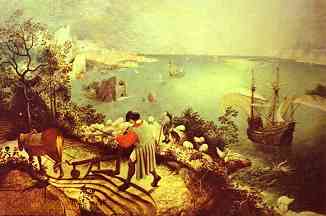
The title "How it takes place" is extracted from the poem "Musée des Beaux Arts" of W.H. Auden, at its turn referring to "The Fall of Icarus" by Breughel. The spectator is drawn to the spatial effect of the composition: distant mountains, a boat sailing on the sea and a farmer working in the foreground. In the bottom right-hand corner -only a small detail- two legs of a drowning Icarus disappear in the sea. Apart from the references to death and sufferance, the painting and the poem give a good impression of the atmosphere in "How it takes place": some musicians play solo while others play together, smoke cigarettes or have already left the stage.
• instrumentation: voice, clarinet, violin, viola, cello, percussion and standing piano
• performance: 24 October 2001 in Eeklo (B) by het ensemble Champ d'Action
• recording (the piece only starts after 1 minute)
• There is a recording of this piece on a CD with the Belgian magazine A+ (a magazine about architecture). This recording was made by the Flemish classical radio Klara on the première of the concert where the first version of this piece was played.
• This piece was written for a concert by the Belgian ensemble Champ d'Action, on the theme of Music & Architecture. The concert was organised for a new building by the Belgian architect Stephane Beel.
STILTEGEBIEDEN/SILENCE RESERVES
Silent places -i.e. places where the level of the surrounding noise is low- are diminishing rapidly in Western Europe. These places can give the visitor rest and quiet but this peace is constantly endangered because these places are reserves in the middle of a busy and hasty society. The ambiguity of these 'Silence Reserves' is the central theme of this piece.
The audio track consists of recorded, non-modified violin and viola sounds. The violin and viola were prepared and played in different ways, one of them was the gypsy technique which consists of pulling a thin string tied to the violin string.
• instrumentation: violin, viola and audio track
• performances: in the Logos Foundation (Ghent) en in the Muhka museum (Antwerp) in June 2001
• score
RUN!
Run! is inspired by my image of music which is so in a hurry that it passes itself all the time, an image of music that flees away while stumbling but continuing its run. The piano plays an important role in this piece and should have a good repetition mechanism!
The tape consists of short and very fast fragments recorded on the automatic player-piano of the Logos Foundation, afterwards these fragments were edited in the Logos Studio.
• performance: 2 July 2001 in the Musikhochschule Koeln (D) by the Spectra Ensemble
... VON HUNDERTEN, VON TAUSENDEN ...
This piece was written for string orchestra (6 vl I, 6 vl II, 3 vla, 2 vcl, 1cb). The title is a description of the huge sound wealth which can be found in the borderland between music and sound. Melodies, rhythms and harmonies are rather suggested than clearly pronounced. The music is very fragile, it seems as if it can fall apart any moment.
• instrumentation: string orchestra (6 first violins, 6 second violins, 3 violas, 2 cellos and bass)
• performances: in the Netherlands (Breda) and Belgium (Antwerp - Elisabethzaal) in 1999
• score
• commissioned by Prima La Musica
NOWHERE'S CHAOS
Nowhere's Chaos was written for a concert centred around 'The State' (1972) by Louis Andriessen. The latter piece by the Dutch composer is a reflection on the relation between music and politics. My inspiration wasn't the music by Andriessen but the philosophical-utopian tradition which started with the ideal state as described by Plato. The largest part of these Utopia's (like Utopia - Th. More) depicts a rich, just but at the same time authoritarian society. Only 'News from Nowhere' by William Morris is an exception because it is a part of the anarchist tradition. The text used in 'Nowhere's Chaos' is based on excerpts from this old (19th century) book which is still relevant to our times. In 'Nowhere's Chaos' fragments are also used from 'My journey with Aristotle to the anarchist utopia' by Graham Purchase, from press releases by the Zapatistas in Mexico and finally slogans used by Belgian action groups to defend the rights of refugees and illegal people are integrated in this piece.
• instrumentation: soprano and mezzo-soprano, 2 oboes, 2 horns, 2 trombones, 2 trumpets, 4 violas, piano
• performances: by the November Music Orkest conducted by Fabrice Bollon in 's Hertogenbosch (NL), Tilburg (NL) and Maastricht (NL), Antwerp (De Singel, B) and Ghent (De Vooruit, B) and Essen (D) November 1998
• commissioned by festival November Music
NATURE MORTE
Music as a landscape without a human logic, wherein fragments appear and disappear alternately. Nature as a ritual, slow and brutal. The still life of nature but also the anger because of the dying nature.
• instrumentation: flute (piccolo), clarinet (bass cl.), piano, percussion, violin, viola and cello
• performances: by Spectra Ensemble conducted by Filip Rathé in Belgium in the Royal Conservatory of Ghent (1998), SMAK (1999 & 2000), de Rode Pomp (1999, 2002), Antwerp (Zaal 7, 1999), Ename, CC St-Niklaas (2002), de Bijloke (2009), Denmark (Kopenhagen, 1999) and Germany (Duisburg, 2000 and Keulen, 2002); by the ensemble Champ d'Action (Muhka, Antwerp 2001 and the Logos Foundation, 2001)
• score
PHOENIX
Phoenix was commissioned by the Walpurgis Music Theater (B). This theater asked 6 composers from Holland and Belgium to write a (short) piece of music theater on the theme of the bird which arises out of its own ashes, the Phoenix. "Phoenix" doesn't deal with this myth but with fire as an element of nature. On a text by the "first poet of Ireland" Amergin (before 700 A.D.), the singer sings and performs with imploring gestures as in ritual theatre.
• instrumentation: voice, (bass)clarinet, cello and percussion (2 performers)
• performances: in 1996 by the Walpurgis ensemble conducted by Alain Franco in Amsterdam (Felix Meritis, NL), de Vooruit (Ghent, B), CC St.-Niklaas (B), de Velinx (Tongeren, B), CC Deurne and the Limelight in Kortrijk (B)
SAILING THE SEAS OF DOWN BELOW
In this piece I consider the player piano as an instrument different from the regular piano. The player piano is unique in its potential to produce huge polyphony (an orchestra of 88 keys), complex rhythms and superhuman speed. In "Sailing the Seas of Down Below", I exploit these possibilities to the extreme, which results in a very pianistic work: the limits of the player piano (and thus of the piano itself) are explored: thirteen-voice polyphony, combined decelerations and accelerations and fast keyboard runs that one hears as a glissando.
Sailing the Seas of Down Below consists out of two elements that seem contradictory at first: a tight melody in a steady rhythmic pattern (typically mechanical) and intertwining chromatic lines in a very free, improvisatory rhythm (typically human: with tempo changes and rubati). A machine such as the player piano is perfectly capable of solving this contradiction. In the final movement, the first few seconds of the piece are enlarged and presented as a slowly descending sound mass.
• instrumentation: computer-controlled piano
• score
• Sailing the seas of down below is recorded on the CD "New Music for Player Piano" in de Logos series Public Domain
• performances: in the Logos Foundation on the Festival voor Automatische muziek (1995), in the Elzenhof (Brussels, 1996), in the Royal Conservatory of Ghent on the Week van de Hedendaagse Muziek (1996), in the Muhka (Antwerp, 2001), in the Pierement Museum in Utrecht (NL, 2000), in the Muziekcentrum van Den Bosch (NL, 1999), on the Audio Art festial 2002 (Krakau, Polen), the Chants Mechaniques Festival in Lille (F, 2002) and in the Circolo de Bellas Artes (Madrid, 2004)
8 SHORT SONGS
8 short songs on texts of North-American Indians. The character of the songs is very diverse: from odes to a seal to slanging matches and exorcist rituals.
• instrumentation: voice and (prepared) piano
• performances: in 1996 by Hans Roels (prepared piano) and Cornelia Berger (voice) in the Royal Conservatory of Ghent, in the Logos Foundation and in the Elzenhof (CC Elsene, Brussels)
• score